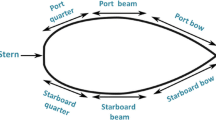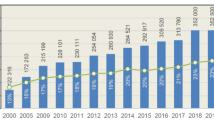Abstract
Purpose
Leisure boaters in the Baltic Sea apply more copper as antifoulant than needed and permitted. Initiatives have been started to identify efficient means making boat owners comply with regulations through changed consumer behavior. We compare the environmental impacts of conventional and alternative antifouling methods, using Life Cycle Assessment methodology.
Methods
Two non-toxic methods were compared with biocide paint. To study the influence of boat owner use patterns, paint and brush washer scenarios (e.g., different paints, amounts, and maintenance) were created based on current use and recommendations. The functional unit was an average Swedish leisure boat kept fouling free for 1 year and impact categories studied were freshwater eco-toxicity and greenhouse gas emissions. Production of paints, fuel, electricity, and material used in the non-toxic methods was included. Sensitivity analysis was performed regarding the characterization method for toxicity, the fuel consumption data, and the copper release data.
Results and discussion
The non-toxic methods, hull cover and brush washer, performed best, but a trade-off was identified when the brush washer was located further away from the home port, when additional transportation increased greenhouse gas emissions. The resources needed for the non-toxic methods (production of materials and electricity used) cause considerably lower toxic emissions than paint. In the paint scenarios, using less paint and cleaning the boat over a washing pad with water treatment reduces aquatic emissions significantly. Fuel-related emissions were consistently lower than paint-related emissions. In the best-performing paint scenario, fuel- and paint-related emissions represented 26 and 67% of total emissions, respectively.
Conclusions
The non-toxic methods hull cover and brush washers lead to lower emissions, especially when brush washers were located close to the home port. Lacking such infrastructure, “painting less” is a way to reduce emissions, by using lower amounts of paint and painting less frequently. More widespread use of these antifouling strategies would considerably reduce copper emissions from leisure boating to the Baltic Sea. We suggest that support to marinas for investments in brush washers and washing pads should be further developed to enable boat owners to choose more sustainable antifouling methods and that information campaigns on the combined economic, health, and ecosystem impacts of antifouling are especially designed for boaters, marinas, market actors, and policy makers for a change to take place towards more sustainable practices.






Similar content being viewed by others
References
Amara I, Miled W, Slama RB, Ladhari N (2017) Antifouling processes and toxicity effects of antifouling paints on marine environment. A review. Environ Toxicol Pharmacol 57:115–130
Andersson S, Kautsky L (1996) Copper effects on reproductive stages of Baltic Sea Fucus vesiculosus. Mar Biol 125(1):171–176
Bamberg S, Möser G (2007) Twenty years after Hines, Hungerford, and Tomera: a new meta-analysis of psycho-social determinants of pro-environmental behaviour. J Environ Psychol 27(1):14–25
Bighiu MA, Gorokhova E, Almroth BC, Wiklund AKE (2017) Metal contamination in harbours impacts life-history traits and metallothionein levels in snails. PLoS One 12(7):e0180157
Bonsdorff E (2006) Zoobenthic diversity-gradients in the Baltic Sea: continuous post-glacial succession in a stressed ecosystem. J Exp Mar Biol Ecol 330(1):383–391
Cerne O, Strandberg J, Fridell E, Peterson K, Allard AS, Rydberg T, Vaske B, Jägersten C, Östman N, Eklund B (2008) Rena Turen–Utvärdering av miljöanpassade bränslen i fritidsbåtar (Pure luck- Evaulation of environmentally adapted fueld in leisure boats, in Swedish). IVL Svenska Miljöinstitutet, Stockholm
Champ MA (2000) A review of organotin regulatory strategies, pending actions, related costs and benefits. Sci Total Environ 258(1):21–71
Cid A, Herrero C, Torres E, Abalde J (1995) Copper toxicity on the marine microalga Phaeodactylum tricornutum: effects on photosynthesis and related parameters. Aquat Toxicol 31(2):165–174
Dafforn KA, Lewis JA, Johnston EL (2011) Antifouling strategies: history and regulation, ecological impacts and mitigation. Mar Pollut Bull 62(3):453–465
Dahlström M, Elwing H, Ytreberg E, Solér C, Dahlström M (2014) Bland borsttvättar och fartygsfärger – En studie av fritidsbåtsägares attityder till och användning av olika antifoulingtekniker (Among brush washers and shiping paints- A study of boaters attitudes to and use of various antifouling techniques, in Swedish) http://changeantifouling.com/wp-content/uploads/2014/10/Ut%C3%B6kad_rapport_bilaga4.pdf
Diaz RJ, Rosenberg R (2008) Spreading dead zones and consequences for marine ecosystems. Science 321(5891):926–929
Dong Y, Rosenbaum RK, Hauschild MZ (2015) Assessment of metal toxicity in marine ecosystems: comparative toxicity potentials for nine cationic metals in coastal seawater. Environ Sci Technol 50(1):269–278
Dong Y, Rosenbaum RK, Hauschild MZ (2018) Metal toxicity characterization factors for marine ecosystems—considering the importance of the estuary for freshwater emissions. Int J Life Cycle Assess 23(8):1641–1653
Eklund B, Eklund D (2014) Pleasure boatyard soils are often highly contaminated. Environ Manag 53(5):930–946
Eklund BT, Kautsky L (2003) Review on toxicity testing with marine macroalgae and the need for method standardization––exemplified with copper and phenol. Mar Pollut Bull 46(2):171–181
Eklund B, Haaksi H, Syversen F, Eisted R (2013) Disposals of plastic end-of-life boats. TemaNord 2013:582, Nordic Council of Ministers 2013, ISBN 978-92-893-2651-3
European Commission (2010) Joint Research Centre - Institute for Environment and Sustainability: international reference life cycle data system (ILCD) handbook - general guide for life cycle assessment - detailed guidance. First edition march 2010. EUR 24708 EN. Luxembourg. Publications Office of the European Union
Gibbs PE, Bryan GW (1986) Reproductive failure in populations of the dog-whelk, Nucella lapillus, caused by imposex induced by tributyltin from antifouling paints. J Mar Biol Assoc UK 66(04):767–777
International Organization for Standardization (2006a) ISO14040:2006 environmental management – life cycle assessment – principles and framework. ISO, Geneva
International Organization for Standardization (2006b) ISO 14044:2006 Environmental Management – Life Cycle Assessment – Requirements and Guidelines. ISO, Geneva
IPCC (2013) Climate change 2013: the physical science basis: working group I contribution to the fifth assessment report of the intergovernmental panel on climate change. Cambridge University Press, Cambridge
Jones B, Bolam T (2007) Copper speciation survey from UK marinas, harbours and estuaries. Mar Pollut Bull 54(8):1127–1138
Karlsson J, Eklund B (2004) New biocide-free anti-fouling paints are toxic. Mar Pollut Bull 49(5):456–464
Karlsson J, Ytreberg E, Eklund B (2010) Toxicity of anti-fouling paints for use on ships and leisure boats to non-target organisms representing three trophic levels. Environ Pollut 158(3):681–687
Katranitsas A, Castritsi-Catharios J, Persoone G (2003) The effects of a copper-based antifouling paint on mortality and enzymatic activity of a non-target marine organism. Mar Pollut Bull 46(11):1491–1494
Koroschetz B, Solér C, Mäenpää E (2017) Bonus Change Deliverable 2.2 Report/Scientific article on Leisure boat owners’ ways of using of antifouling products and techniques and their understanding of environmental consequences
Lagerström M, Norling M, Eklund B (2016) Metal contamination at recreational boatyards linked to the use of antifouling paints—investigation of soil and sediment with a field portable XRF. Environ Sci Pollut Res 23(10):10146–10157
Lagerström M, Strand J, Eklund B, Ytreberg E (2017) Total tin and organotin speciation in historic layers of antifouling paint on leisure boat hulls. Environ Pollut 220:1333–1341
Lagerström M, Lindgren JF, Holmqvist A, Dahlström M, Ytreberg E (2018) In situ release rates of cu and Zn from commercial antifouling paints at different salinities. Mar Pollut Bull 127:289–296
Rosenbaum RK, Bachmann TM, Gold LS, Huijbregts MA, Jolliet O, Juraske R et al (2008) USEtox—the UNEP-SETAC toxicity model: recommended characterisation factors for human toxicity and freshwater ecotoxicity in life cycle impact assessment. Int J Life Cycle Assess 13(7):532–546
Schiff K, Diehl D, Valkirs A (2004) Copper emissions from antifouling paint on recreational vessels. Mar Pollut Bull 48(3):371–377
Srinivasan M, Swain GW (2007) Managing the use of copper-based antifouling paints. Environ Manag 39(3):423–441
Strandmark A, Bring A, Cousins SA, Destouni G, Kautsky H, Kolb G et al (2015) Climate change effects on the Baltic Sea borderland between land and sea. Ambio 44(1):28–38
Swedish International Development Authority/FAO Gulbrandsen O (1986) Reducing the fuel costs of small fishing boats
Swedish Transport Agency (2010) Båtlivsundersökningen 2010. En undersökning om svenska fritidsbåtar och hur de används (Boat survey 2010. A study on Swedish leisure boats and how they are used, in Swedish)
Swedish Transport Agency (2016) Båtlivsundersökningen 2015. En undersökning om svenska fritidsbåtar och hur de används (boat survey 2015. A study on Swedish leisure boats and how they are used, in Swedish) Report number TSG 2016–534
Swedish Transport Agency (2018) Ren båtbotten (Clean boat hull, in Swedish) https://www.transportstyrelsen.se/sv/sjofart/Fritidsbatar/Batlivets-miljofragor/Ren-batbotten/. Accessed 26 Feb 2018
Tedengren M, Arner M, Kautsky N (1988) Ecophysiology and stress response of marine and brackish water Gammarus species (Crustacea, Amphipoda) to changes in salinity and exposure to cadmium and diesel-oil. Mar Ecol Prog Ser 47:107–116
Valkirs AO, Seligman PF, Haslbeck E, Caso JS (2003) Measurement of copper release rates from antifouling paint under laboratory and in situ conditions: implications for loading estimation to marine water bodies. Mar Pollut Bull 46(6):763–779
Voulvoulis N (2006) Antifouling paint booster biocides: occurrence and partitioning in water and sediments. In: Antifouling paint biocides. Springer Berlin Heidelberg, pp 155–170
Watermann BT, Daehne B, Sievers S, Dannenberg R, Overbeke JC, Klijnstra JW, Heemken O (2005) Bioassays and selected chemical analysis of biocide-free antifouling coatings. Chemosphere 60(11):1530–1541
Wernet G, Bauer C, Steubing B, Reinhard J, Moreno-Ruiz E, Weidema B (2016) The ecoinvent database version 3 (part I): overview and methodology. Int J Life Cycle Assess 21(9):1218–1230
Yamaha (2002) Yamaha körfakta. (Yamaha driving facts, In Swedish) http://www.batvaruhuset.se/documents/batvaruhuset/documents/korfakta_2002_tcm36-34329.pdf2002. Accessed 13 July 2015
Ytreberg E, Karlsson J, Eklund B (2010) Comparison of toxicity and release rates of cu and Zn from anti-fouling paints leached in natural and artificial brackish seawater. Sci Total Environ 408(12):2459–2466
Acknowledgements
We are grateful to the CHANGE team for the valuable questions and comments along the way, and for new insights about antifouling. We also thank Odd Klofsten for contributing with information on brush washers. This work resulted from the BONUS CHANGE project and was supported by BONUS (Art 185), funded jointly by the EU and the Swedish Environmental Protection Agency.
Author information
Authors and Affiliations
Corresponding author
Additional information
Responsible editor: Zbigniew Stanislaw Klos
Rights and permissions
About this article
Cite this article
Bergman, K., Ziegler, F. Environmental impacts of alternative antifouling methods and use patterns of leisure boat owners. Int J Life Cycle Assess 24, 725–734 (2019). https://doi.org/10.1007/s11367-018-1525-x
Received:
Accepted:
Published:
Issue Date:
DOI: https://doi.org/10.1007/s11367-018-1525-x




